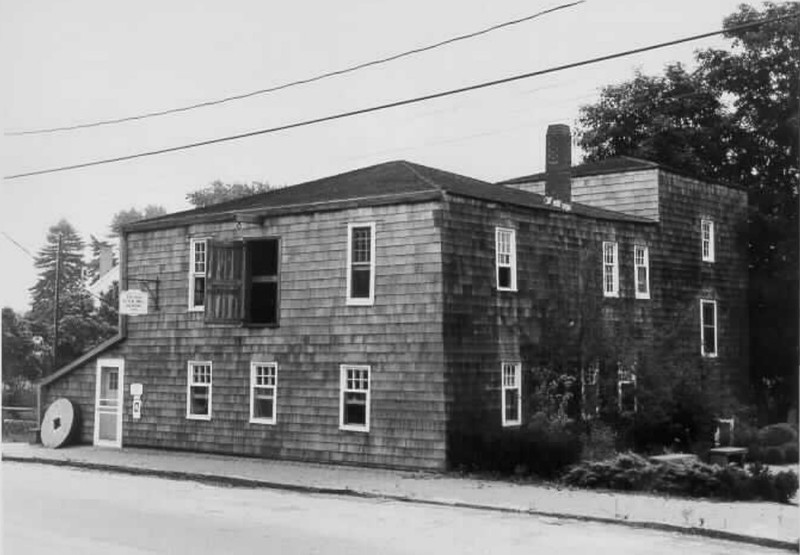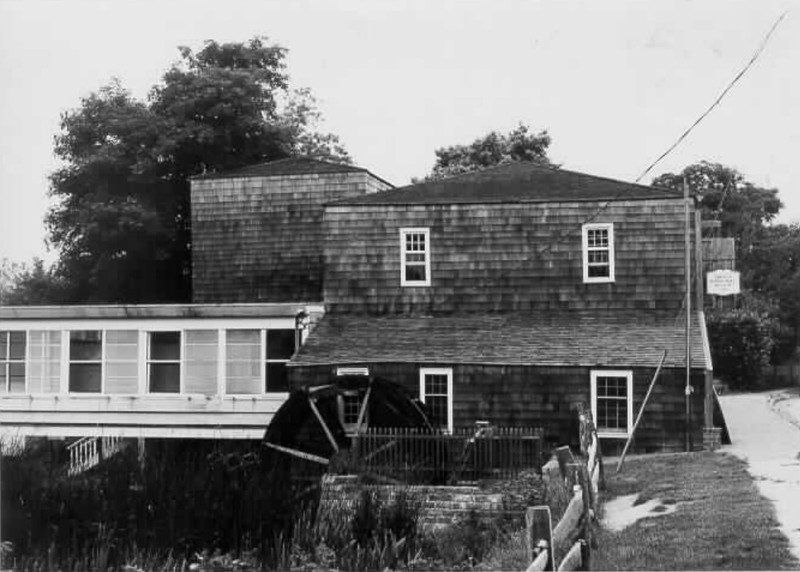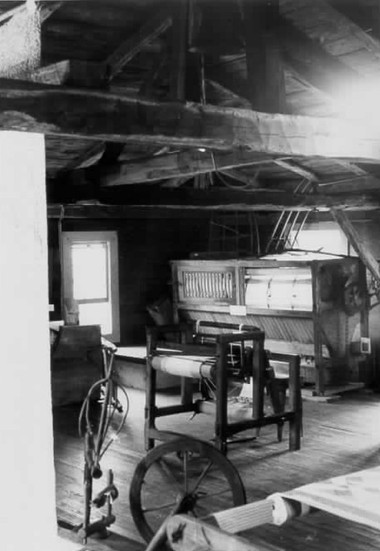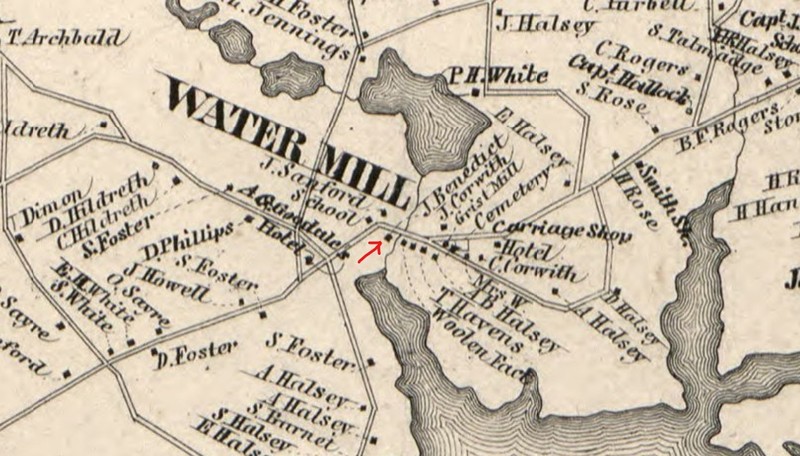Water Mill Museum
Introduction
Text-to-speech Audio
An historic grist mill at 41 Old Mill Road has been turned into the Water Mill Museum. The mill was built in 1644 and the village is named after this mill. The mill building was originally on the north side if the road and was moved to the opposite side of the road in the eighteenth century. Old Mill Road runs along the top of the earthen mill dam; the mill pond is on the north side of the road. The Water Mill is one of the oldest surviving mills on Long Island. The Water Mill building was listed in the New York and National Registers of Historic Places in 1983. The museum is open from late May to late October from Thursdays through Sundays, featuring a restored, working mill, exhibits on local industries and the Civil War, and displays of members' artwork.
Images
North and west sides of Water Mill Museum in 1980 photo for NRHP (Austin O'Brien)

East elevation and water wheel of Water Mill Museum in 1980 photo (O'Brien)

1980 view of interior of main part of Water Mill Museum, second floor (O'Brien)

Water Mill building, owned by J. Benedict, on 1858 map of Water Mill area (Robert P. Smith)

Backstory and Context
Text-to-speech Audio
Edward Howell constructed the dam and mill at Mecoxe in 1644 in exchange for 40 acres of land from the town of Southampton. Settlers of the nearby village of East Hampton were allowed to bring their grain to be ground at the mill in exchange for regulating the water level in Mecox Bay. A settlement devloped near the mill and the name was changed to Water Mill. Howell sold the mill and property to William Ludlum in 1653. A weaver named Elias Petty purchased the mill in 1748 and converted the machinery to spin yarn and weave and full cloth. The mill was converted again in the early nineteenth century by Jesse Hedges and John White to manufacture paper. The mill continued to be used for papermaking by the Benedict family from 1825 to the early twentieth century. The mill went through three more functions - ice storage, a boys' club, and a shop - before being purchased from the Benedicts in 1942 by the Ladies Auxiliary of Water Mill. After stabilizing and repairing the building, they opened the museum in 1969. During the summer months, the auxiliary operated the mill to grind grain into flour.
There are two building sections in the mill building. The square, two-story, hipped-roof main section with a full basement and an interior chimney on the west side lies close to the road. A one-story, shed-roof wing to the east of the main block has the water wheel and mill race on the east side. The mill race runs southward from the millpond under the road to the east side of the mill, and then empties into Mill Creek. An undershot wooden water wheel with a diameter of 12 feet and a stone support wall were replaced in the 1970s. Attached to the rear (south) of the main block are a two-and-a half story tower and a glass-walled one-story porch from the 1930s. The main entrance to the mill was moved in the 1930s to enter the east addition instead of the main block. There is a loft opening with a wooden door and hoist in the center of the front facade on the second story.
The heavy mortise-and-tenon wood frame of the main block is visible inside on all levels, plus the wood planking that the exterior shingles attach to. The tower was being used for storage when the building was documented for the National Register in 1983. While most of the milling apparatus has been removed, there are still heavy wood frame supports, large grinding stones, and an eighteenth-century tub wheel.
The Water Mill Museum is still run by the auxiliary and re-opened for the summer on May 27th 2021, after being closed in 2020 due to the pandemic. It closes for the season on October 27th 2021.
Sources
O'Brien, Austin. NRHP Nomination of Water Mill Museum, Water Mill, N.Y.. National Register. Washington, DC. National Park Service, 1983.
Water Mill Museum. Home, Water Mill Museum. May 1st 2021. Accessed June 22nd 2021. https://watermillmuseum.org/.
New York State Cultural Resource Information System (NYS CRIS): https://cris.parks.ny.gov/
NYS CRIS: https://cris.parks.ny.gov/
NYS CRIS: https://cris.parks.ny.gov/
Library of Congress: https://www.loc.gov/item/2013593235/
